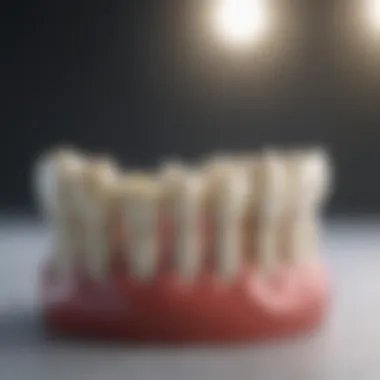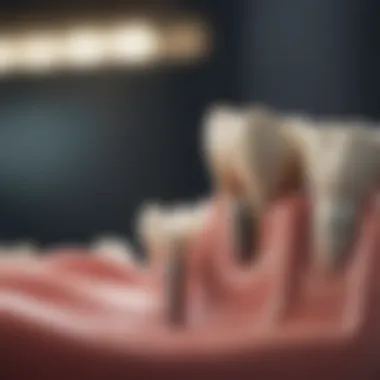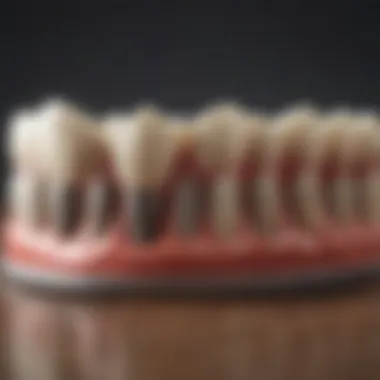Understanding Dental Crown Costs: Key Factors Explained


Intro
Understanding the cost of dental crowns is crucial for anyone considering this dental procedure. Crowns might be necessary for various reasons, such as protecting a weakened tooth, restoring a broken tooth, or improving the aesthetics of a tooth. This article aims to break down the financial implications associated with dental crowns, allowing individuals to make informed choices. In this comprehensive analysis, we will discuss insurance and credit card options that can lessen the financial burden.
Overview of Insurance and Credit Card Options
Health insurance can significantly impact the out-of-pocket expenses for dental crowns. Understanding types of coverage is key. Let's examine some common insurance products available today.
Types of Insurance Products
- Dental PPO Plans: Preferred Provider Organizations generally offer the widest range of choices. Members usually pay lower rates for using in-network dentists. Understanding details such as deductibles and annual maximums is vital.
- Dental HMO Plans: Unlike PPOs, Health Maintenance Organizations may require choosing a primary dentist and often have limited coverage options. Despite that, premiums are generally lower.
- Indemnity Plans: More traditional dental insurance allows freedom in choosing providers. However, policyholders may face higher upfront costs, as the insurance usually reimbursement claims after treatment.
- Discount Dental Plans: These are not insurance. Instead, subscribers pay an annual fee to access available discounts when choosing dental services. Crowns could become more affordable with this option.
For effective financial planning, carefully reviewing policy limits and specific coverage for crowns is advisable.
Credit Card Categories
Using credit can also facilitate dental crown payments. Here are popular categories:
- Rewards Credit Cards: Offer points for every dollar spent, which can lead to travel, cash back, or other rewards.
- 0% APR Promotional Cards: These cards allow you to finance dental work interest-free for a specified time. It may help to avoid interest on big bills.
- Healthcare Credit Cards: Some options specialize in financing healthcare expenses which may provide flexible repayment terms for dental services.
Comparative Analysis
Before making decisions, a comparison can bring clarity. Choosing the right insurance plan and card matters a lot for managing the costs.
Comparison of Insurance Plans
When looking at insurance:
- Assess premiums and out-of-pocket maximums.
- Consider coverage limitations and waiting periods.
- Check network dentists and their reputation.
Credit Card Comparison
Evaluate the following aspects of credit options:
- Interest rates and promotional offers to avoid high costs.
- Fees for late payments or balance transfers.
- Bonus offerings for new cardholders.
Expert Insights and Recommendations
Consulting with industry professionals offers additional layers of insight into making sound financial decisions. Here are their viewpoints:
Industry Expert Opinions
Dentists often recommend seeking quotes from different dental offices. Each may have varying payment plans that thus affect overall dental care costs.
Data-Backed Recommendations
According to several studies, maintaining dental insurance can lead to better long-term oral health and financial savings.
Strategies for Financial Decisions
Next is how to effectively choose both insurance and credit card options. These strategies can significantly affect your cost journey.
How to Choose the Right Insurance
Selecting an insurance plan is a blend of analyzing need and market. Here are a few actions:
- Review your oral health history to understand potential future dental needs.
- Seek potential extra coverages specifically for advanced services like crowns.
- Compare various insurer networks to ensure the desired dental provider is included.
Maximizing Credit Card Potential
To optimize your use of credit, consider these strategies:
- Make timely payments to avoid fees.
- Utilize rewards benefits effectively when using the card for dental expenses.
- Stick to payment restructuring within any promotional agreements to avoid high-interest rates.


Resources for Additional Learning
Valuable tools for further understanding can include:
- Dental Cost Calculators: They help estimate total costs based on insurance.
- Glossaries on Dental Vocabulary: Familiarize yourself with common terms like “in-network” or “deductible” for smart conversations.
For more resources, check platforms like Wikipedia and Reddit.
In summary, this analysis provides essential component details regarding costs associated with dental crowns. Whether you choose insurance, credit cards, or both, reputable practices will cushion the burden of dental investing. This understanding is invaluable for making educated decisions about one’s oral healthcare spending.
Prolusion to Dental Crowns
Dental crowns play a critical role in modern dentistry, serving as a versatile solution for both aesthetic and restorative needs. Understanding the ins and outs of dental crowns helps individuals navigate their dental health proactively. This section highlights the basic definitions, purposes, and the significance chairs for dental crowns in restorative care. It also contextualizes the financial aspects which will be addressed later in this article.
What is a Dental Crown?
A dental crown is a type of cap or cover that is placed over a tooth. It is designed to restore its shape, size, strength, and appearance. The fitting of a crown typically involves grinding down the existing tooth to ensure a proper fit. Crowns can be composed of various materials including porcelain, metal, or a mix of these materials. Their design caters to both functionality and aesthetics, making them a favorable option for teeth that are damaged, weakened, or malformed.
When considering dental crowns, it’s essential to comprehend their custom nature. Each crown is molded to fit the specific contours of the tooth it is covering. This customization assures a precise and comfortable fit while ensuring the patient's bite remains intact.
Purpose of Dental Crowns
The purposes of dental crowns go beyond mere cosmetic improvement. Here are some key functions:
- Restoration of Damaged Teeth: Crowns are often utilized on teeth that have been severely chipped or cracked due to trauma, decay, or other dental health issues. They help in preventing further damage by acting as a protective shell.
- Support for Weak Teeth: Teeth that have undergone significant decay may require a crown to maintain their functionality. In such cases, crowns prevent additional decay and promote long-term health throughout the mouth.
- Anchor for Dental Bridges: In situations when multiple teeth are missing, crowns can serve as anchors for dental bridges. This adds stability to restorative efforts.
- Cosmetic Enhancements: Crowns are also used in cosmetic dentistry to address aesthetic issues. Porcelain crowns, in particular, can closely mimic natural teeth in color and translucency.
Understanding the varied purposes of dental crowns is essential when considering the investment in oral health, laying the foundation for discussions on costs and financing options presented in the subsequent sections.
“Dental crowns are not merely restorative tools; they are bridges to maintaining oral health and are often necessary for an individual's overall wellbeing.”
Factors Influencing Crown Costs
Understanding the costs associated with dental crowns goes beyond simple price tags. Factors influencing crown costs are crucial to grasp as they illuminate both financial and health-related implications. Various elements come into play when determining the price of a crown, including the material from which it is made, the geographic location of the dental practice, the expertise of the dentist, and the complexity of the procedure itself. Each of these factors holds significance that can profoundly aid patients in making informed choices regarding their dental health. The right insight into these aspects allows for proper expectation management and aids patients in navigating the world of dental options more effectively.
Material Types and Their Costs
The selection of material for dental crowns greatly impacts overall costs. Each material comes with its distinct qualities, advantages, and limitations. Understanding these options can guide patients in their decision-making process.
Porcelain Crowns
Porcelain crowns are notable for their aesthetic appeal. They closely mimic the natural shade and translucency of tooth enamel, making them ideal for visible teeth. The primary advantage of porcelain crowns is their ability to blend seamlessly with natural teeth. Many people find them to be a satisfactory choice due to their cosmetic benefits. However, they may be less durable than other materials. High-stressing activities such as grinding teeth can lead to possible chipping or cracking. Overall, their attractiveness makes them a popular choice despite some risk to longevity.
Metal Crowns
Metal crowns provide a different set of benefits. They are typically made from alloys that include gold, palladium, or nickel. The hallmark of metal crowns is their exceptional strength, making them highly resistant to wear and tear, especially in areas of high bite pressure. This durability makes them a long-lasting solution. However, the noticeable metallic appearance can be a disadvantage for those seeking a more discreet option. On a different note, metal crowns usually come with a lower price tag compared to porcelain. Thus, they can be a practical option in terms of economy while offering considerable longevity.
Composite Crowns
Composite crowns represent another approach, composed of tooth-colored resin. They offer a more cost-effective alternative while still providing visual aesthetics. Patients appreciate the ability of composite crowns to match the existing tooth color closely. However, compared to porcelain and metal options, composite crowns may be less durable and can experience wear over time. This material serves well for patients prioritizing immediate appearance adjustments, but they may not be ideal for long-term use particularly in molar regions where pressure can lead to earlier degradation.
Geographic Location Impact
The cost of dental crowns can differ notably based on geographic location. Urban experts or those in affluent areas may command higher prices, reflecting their overhead expenses. Meanwhile, smaller towns often present more competitive pricing structures. Understandably, geographical differences play a significant role in overall expense, reinforcing the wisdom of conducting research before choosing a dental provider. The regional cost variations should not deter pursuit of quality crowns but rather inform surgical choices based on local market conditions.
Dentist's Experience and Reputation
The level of expertise and reputation of the dentist constitutes another pivotal factor affecting crown costs. Dental professionals with extensive training and experience often charge more for their services. Their ability to deliver precision reflects their higher rates, as seasoned dentists minimize complications, ensuring fewer visits or follow-up issues. However, patients should weigh out future potential costs versus initial expenses. Choosing a knowledgeable dentist might bring spiritual confidence, safeguarding dental well-being.
Complexity of the Procedure
Finally, the complexity involved in the crown procedure plays an integral role. More complicated cases require more resources and time, leading to increased costs. A crown that involves preparing the tooth for a large decay may be significantly more expensive than one requiring minimal preparation. Hence, understanding individual needs and conditions helps establish appropriate expectations regarding expenses.
Average Costs of Dental Crowns


Understanding the prices associated with dental crowns is key in navigating dental care. The costs can widely vary due to several influences such as the type of crown, the geographic location of the practice, and individual insurance plans. Recognizing these factors helps individuals understand their potential financial commitment and make informed decisions. This part will especially consider two main aspects: national averages and the impact of insurance coverage on the overall cost structure.
National Averages and Variability
The national average cost of a dental crown ranges significantly depending on various factors. Generally speaking, patients can expect to pay between $800 to $3,000 for a single crown.
Factors that create variability within this range include:
- Material Used: Different crown materials have different costs. For instance, porcelain crowns often fall on the higher end of the spectrum, whereas metal crowns are typically less expensive.
- Procedure Complexity: If the tooth being crowned requires additional work such as root canal therapy or intense shaping, this can increase costs.
- Location: Urban centers usually command higher prices compared to rural locations due to cost of living and demand.
It is also important to be aware of what influences the national average. People in certain states often pay much more largely because of specific local regulations or market conditions. For example, states like California and New York typically have higher costs than places like Arkansas and Kentucky. Thus, it is wise to consult local providers to gather concrete estimates relevant to specific circumstances.
Insurance Coverage for Crowns
Dental insurance can significantly reduce out-of-pocket expenses. Many insurance plans cover a portion of the cost associated with dental crowns, often defining it as a necessary restorative procedure. However, coverage details can differ by insurance provider and individual policy.
Generally, dental insurances may cover around 50% to 80% of crown costs. Several key factors regarding insurance coverage include:
- Type of Insurance: Plans might differ in how they value preventive care versus restorative work.
- Deductibles and Coinsurance: Patients will have different amounts they need to pay initially before insurance kicks in.
- Product Limits: Many plans have an annual limit on how much they will cover, affecting patients who need multiple crowns in a given year.
Obtaining quotes from insurance providers can clarify expenses tied to receiving a dental crown. Furthermore, some practices may offer payment assistance options if insurance does not cover a significant portion. Therefore, buyers should review their policy and talk to the dental office to find the best possible financial arrangement.
Understanding the costs linked to dental crowns is essential for effective management of oral health expenses. Being informed helps avoid surprises when seeking treatment.
Alternative Options to Dental Crowns
When considering dental care, many patients are aware they might need a dental crown. However, not everyone knows that there are several alternative options available. Understanding these alternatives is critical, as it provides different avenues for addressing dental issues while also allowing individuals to manage costs and long-term oral health outcomes.
Dental Bridges
Dental bridges can serve as an effective solution for replacing missing teeth. Unlike crowns, which encase damaged or decayed teeth, bridges fill the gap between teeth using a replacement tooth anchored by two adjacent teeth.
Benefits of Dental Bridges
- Cost-effective: Typically, dental bridges may have a lower overall cost than dental crowns.
- Restorative function: They do not just serve aesthetic purposes; they also help in maintaining dental alignment and bite integrity.
- Time efficiency: The preparation and installation process is generally quicker compared to crowns.
However, it is important to consider that bridges require alteration of neighboring teeth, which might not always be desirable. As a standard practice, dental professionals will assess the individual needs and preferences before recommending a bridge.
Veneers
Veneers present another quality option, particularly for patients focused on aesthetics. These are thin shells made from porcelain or resin composite materials, which are affixed to the front surface of teeth.
Considerations for Using Veneers
- Aesthetic improvement: They provide a natural appearance and can conceal slight imperfections like stains or minor misalignments.
- Less invasive: In many instances, the application of veneers requires less tooth structure to be removed compared to crowns.
- Longevity: While not as durable in function as crowns, veneers can last several years with proper care.
Despite their many advantages, it is essential to note that veneers are primarily suited for cosmetic improvements. They may not address more severe dental issues such as decay or significant structural loss.
Fillings
Fillings are among the simplest solutions for treating small cavities and minor damage in teeth. They involve removing decay and filling the empty space, thus preserving the integrity of the tooth while restoring its function.
Pros and Cons of Fillings
Pros:
- Cost-efficient: Fillings generally cost much less than dental crowns, making them an attractive option for many people.
- Quick procedure: The process for fillings is often straightforward and does not require extensive dental procedures.
Cons:
- Not suitable for major damage: If the damage to a tooth is significant, a filling may not be effective or long-lasting.
- Potential for wearing over time: Certain filling materials, such as composites, may wear down more quickly than crown options.
Understanding these alternative options provides valuable insights for patients contemplating their dental health choices. By weighing the pros and cons, they can make informed decisions that best meet their individual needs and budgets.


Financing Dental Crowns
Understanding the cost of dental crowns is crucial, but financing options often play an equally important role. Exploring financing for dental crowns reveals various ways individuals can manage costs and alleviate the burden associated with dental work. It is significant to recognize that while crowns are an investment in oral health, available financing solutions can help make this investment more accessible.
For many families and individuals, paying for dental crowns can present a financial challenge. Thus, options like payment plans or Health Savings Accounts can provide much-needed flexibility. Delving into these options will not only inform individuals about viable funding alternatives but also promote more proactive dental health decisions.
Payment Plans and Options
Financial institutions and dental practices frequently offer payment plans tailored to fit a patient's budgeting needs. This allows patients to spread their payments over months or even years. Many dental offices are willing to work with patients to create customized plans, emphasizing the desire to make essential dental services more affordable.
Payment options may vary significantly, and it is essential to consider the following:
- Zero-interest options: Some providers have agreements with financial institutions that allow no interest if paid in full within a certain timeframe.
- Low monthly payments: Practices might offer alternatives that could reduce the burden of high upfront costs, making dental crowns more accessible.
- Flexible terms: Various lengths of repayment terms give patients the ability to choose a plan matching their financial situation.
Understanding these choices enables individuals to make informed financial decisions that prioritize both their oral health and financial well-being.
Health Savings Accounts (HSAs)
Health Savings Accounts provide another avenue for financing dental crowns. These accounts allow patients to deposit pre-tax income, which can then be used for qualified medical expenditures, including dental work. Using HSAs comes with several advantages:
- Tax advantages: The funds contributed to HSAs are tax-deductible and remain tax-free as long as they are spent on eligible expenses, offering significant savings each year.
- Roll-over benefits: Unlike Flexible Spending Accounts (FSAs), any unused HSA funds can roll over each year, promoting long-term savings.
- Accessibility: HSAs provide insured patients with another means to cover costs not accounted for through typical insurance coverage, leading to better overall financial health.
Ultimately, exploring financing options—such as payment plans and HSAs—empowers individuals to take charge of their dental health and financial futures. These resources make dental procedures like crowns more attainable, reducing the stress often associated with unexpected dental expenditures.
"Financing options can transform the dental experience into a more manageable and positive one."
The Long-term Value of Dental Crowns
Understanding the long-term value of dental crowns offers essential insights into their role in oral health care. Though the immediate cost may raise concerns, it is important to consider the broader context. Investing in dental crowns can enhance both personal health and overall quality of life.
Durability and Lifespan
Dental crowns are designed for longevity. Generally, crowns made from materials like porcelain, metal, or ceramic can last from 10 to 15 years, sometimes longer with proper care. Patients should consider their lifestyle, dental hygiene habits, and personal health when evaluating the anticipated lifespan of a crown.
Several factors contribute to the durability of a crown. Stronger materials such as porcelain-fused-to-metal are preferred for areas requiring high resistance to chewing forces. While porcelain crowns offer aesthetic appeal, they may be more susceptible to wear over time. That said, their appearance often justifies their use in visible areas of the mouth.
Here are key considerations related to durability and lifespan:
- Material Selection: Different materials have varying strengths and weaknesses.
- Oral Hygiene: Good dental habits can extend a crown's life.
- Dentist's Skill: A well-placed crown will perform better and have a longer life.
Impact on Oral Health
More than just restoring a single tooth, dental crowns provide numerous benefits to overall oral health. A well-placed crown can help in maintaining the alignment of teeth, preventing shifts and, potentially, malocclusion.
Oftentimes, crowns support weakened teeth. This prevents further damage and avoids more complex procedures in the future. They also facilitate proper chewing function and can even support adjacent teeth which might otherwise be compromised.
“Dental crowns can be viewed as protective devices, ensuring that natural teeth remain intact and functional.”
Important benefits of crowns include:
- Repair of Damage: Prevents further injury to a fractured or decayed tooth.
- Prevention of Tooth Loss: Maintains the existing tooth structure.
- Enhanced Appearance: Improves the aesthetics of the smile.
In summary, dental crowns present clear long-term benefits. Focusing on durability, lifespan, and the overall impact on oral health, they justify their cost and serve as valuable assets to one's dental care plan.
Culmination
The conclusion serves as a critical section in this article by summarizing various aspects of dental crowns that are essential for making informed decisions. Incorporating insights from previous sections, it consolidates the costs associated with dental crowns, the factors influencing these costs, and the financing alternatives available to individuals.
Summarizing Costs and Benefits
When considerin the cost of dental crowns, clients should be aware of key factors that affect pricing. This includes the materials used, with porcelain crowns typically being more aesthetically pleasing but often pricier than metal options. Understanding the average costs regionally is also vital, as geographical location can significantly change the amount required to get a crown installed.
Moreover, the experience of the dentist can impact the fee while mediating complexity in procedures can add significant expenses. Insuranc coverage should not be overlooked - some plans partially cover crowns, which can reduce out-of-pocket costs.
Here is a recap of the influences on crowns costs:
- Material Types: Porcelain is often costlier than metals, altering cost perceptions.
- Geographical Differences: Major cities usually present higher dental fees compared to rural areas.
- Practitioner’s Expertise: An experienced dentist may have higher charges but often guarantees better outcomes.
- Procedure Complexity: More complex cases, like root canals before crowning, add additional costs.
In recognition of the long-term value of crowns, one must weigh their durability and the substantial advantages they provide in maintaining oral health compared to potential alternatives such as dental bridges or veneers. Ultimately, investing in dental crowns should be viewed not merely as an immediate expense but rather as a worthwhile contribution to one's overall health and well-being.
Informed decisions rely heavily on an understanding of cost breakdowns. Whether you are making a decision alone or alongside family members, synthesized knowledge empowers you to select the necessary steps for optimal dental care.







